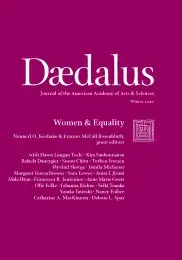What’s Policy Got to Do with It? Race, Gender & Economic Inequality in the United States
In the United States, economic inequality is both racialized and gendered, with Black and Latina women consistently at the bottom of the economic hierarchy. Relative to men (across racial groups) and White women, Black and Latina women often have less-desirable jobs, lower earnings, and higher poverty rates. In this essay, we draw attention to the role of the state in structuring such inequality. Specifically, we examine how public policy is related to racial inequities in economic positions among women. Applying an intersectional lens to the contemporary landscape of economic inequality, we probe the associations between public policies and economic outcomes. We find that policies have unequal consequences across subgroups of women, providing prima facie evidence that state-level decisions about how and where to invest resources have differential implications based on women’s race and ethnicity. We encourage scholars to use aspects of our approach as springboards for better specifying and identifying the processes that account for heterogeneous policy effects across racial subgroups of women.
In the United States, economic inequality is both racialized and gendered.1 This means that the intersecting categories of race and gender are systematically associated with wide disparities in economic outcomes. For example, women across racial groups earn less income than men, but Black and Latina women earn less than both White women and Black and Latino men.2 Similar patterns occur across a variety of economic indicators. In terms of income, poverty, and employment, Black and Latina women remain marginalized: they have the lowest earnings, face the most intense occupational segregation, and have the highest poverty rates.3
Sociologists, economists, and other social scientists have identified a host of factors that explain the relative economic status of Black and Latina women. Racial discrimination, constrained social networks, labor market inequities, and much more underlie the processes that generate disparate material outcomes for Women of Color.4 Still, there is a lot we do not know about the mechanisms that stratify Black and Latina women. In particular, scholars have an inadequate understanding of how public policy affects women’s economic positioning by gender and race.
In this essay, we investigate whether and how social and economic policies differentially shape women’s economic positioning across racial and ethnic groups. We begin by charting disparities between White women and Women of Color across a range of key economic indicators including educational attainment, employment, wages, and poverty. Then, we assess statistical associations between economic outcomes and state-level policies for White, Black, and Latina women. We find substantial heterogeneity in the relationships between economic policies (such as minimum wage laws and disability insurance), social policies (such as cash, food, and medical assistance), and the economic status of women across racial and ethnic groups. Our empirical and theoretical approach is grounded in the concept of intersectionality, a framework developed by Black feminist scholars to capture how a multiplicity of intersecting social identities determine one’s power, life experiences, political interests, and more.5 By adopting an intersectional approach, scholars can study heterogeneous groups with more nuance, remaining attentive to various junctions of different social positions and categories. Applying the lens of intersectionality to questions about economic inequality prompts us to investigate the ways that Women of Color–specifically Latina and Black women–are affected by social and economic policies relative to their White counterparts. Doing so reveals the complex role of the state in gendering and racializing economic inequality.
Numerous factors shape race and gender inequalities in economic outcomes, but we stress the role of policy, bringing the state more into view.6 Concentrating on social and economic policies–primary levers through which government determines and regulates access to resources–is important for three reasons.
First, policy is uniquely vital to producing and reducing inequality. The state wields enormous power to differentially determine the fortunes of its denizens.7 The New Deal of the 1930s offers especially pertinent lessons on how policy can create, maintain, and exacerbate racialized and gendered economic inequality.8 One of the centerpieces of the New Deal–Social Security/OAI (Old Age Insurance)–included provisions that disqualified workers in the agricultural and domestic industries.9 These provisions meant that nine out of ten African American women workers were automatically rendered ineligible.10 Social Security did not incorporate domestic workers until 1948 and agricultural laborers were left out until 1950.11 Despite its prominent status as “the closest thing to a race-blind social program the United States has ever known,” Social Security was marked by inequity at its origins. This was particularly consequential for Black women, who lost state-based financial resources for well over a decade during a time when others were gaining them.12 Policy matters for inequality.
The second reason we center policy in our analytical approach is because it is amenable to change. When the design or implementation of policy exacerbates inequality, policy-makers, advocates, and other engaged members of the political community can work to modify and improve it. The ability of such actors to advance change hinges upon knowledge about how public policy affects economic inequality. To extend the previous example with a more contemporary focus, Social Security continues to have disproportionate effects on Americans by race and ethnicity, with lower total benefit amounts for People of Color.13 This disparity is no longer the result of occupational exclusion. Instead, it stems from larger structural realities: Black and Latino Americans spend fewer years in the workforce, make less income from work, and do not live as long as their White counterparts.14 Unless we are attentive to such policy inequities, we can neither conceptualize nor configure policy to account for such disproportionalities.15
The third reason we emphasize policy is because it reflects and affects democracy. Political institutions that are part and parcel of the democratic process produce and enable economic inequality. Federalism, for instance, exacerbates racialized economic inequality through social policy. Historically, Aid for Dependent Children (cash assistance) resulted in unbalanced welfare coverage by race and ethnicity, with Black Americans receiving significantly less than their White counterparts.16 More contemporary cash assistance programs, such as Aid to Families with Dependent Children (AFDC) and its successor Temporary Assistance for Needy Families (TANF), have also been marked by the institution of federalism in ways that reinforce economic disparities by geography, race, and ethnicity.17 Even in-kind benefits like health insurance proliferate such inequities through the mechanism of federalism.18 These differential outcomes by state reveal the ways policies are shaping Americans differently within a federated political structure. By determining access to and experiences with government resources meant to bolster economic security, the political institutions that contour the delivery of public policy both reflect and affect democratic politics. Such processes of policy feedback–the term used to describe the recursive relationship between policy and politics–have profound implications for democracy.19 Given the relationship between policy and democracy, it is imperative to assess the connections between public policy, economic inequality, race, and gender.
When the economy goes through a process of restructuring, resulting changes affect individuals differently based on their gender, class, race, and ethnic positioning in the social hierarchy. For example, the industrial restructuring of the economy between the 1970s and 1990s had disparate effects on Americans by race and gender.20 Sociologist Irene Browne found that processes of reindustrialization during this period disproportionately affected young Black women who experienced high increases in unemployment as a result of the expansion of retail trade industries.21 Young White women were not similarly affected. Although the 1980s are often depicted as an era that reduced economic inequalities for women, Black women actually experienced greater economic inequality, decreased earnings, and increased unemployment during this time.22
The 2007 recession is another important instance of how economic conditions divergently shape the lives of women. During the recession, Black and Latina women across levels of educational attainment experienced the highest unemployment rates compared with women from other racial and ethnic groups.23 Even after the recession officially ended, the unemployment rates for Latina and Black women remained high: the number of Latina and Black young women who were unemployed increased from 25.3 percent in 2007 to 40.5 percent in 2010.24 Similarly, while the postrecession poverty gap between men and women reached a historic low in 2010 (with 16.2 percent of women and 14.0 percent of men living in poverty), poverty rates were highest among Latina and Black women.25 Both historical and contemporary economic shifts highlight the exceptionally precarious position of Women of Color in the American economy.
Public policies are widely purported to provide stability and security in the face of such precarity. But do policies counterbalance the racial disproportionalities of the economy or do they perpetuate such imbalances? This question is too large for any single essay. Thus, we focus deliberately on social and economic policies designed to support those who are most vulnerable to shifts in the economy, with an emphasis on the divergent implications of such policies for women who are differentially positioned within the labor market.
The social policies we are most concerned with are those primarily directed at helping people to secure the necessities of material survival like food, medical care, and cash. Key social policies include the Supplemental Nutrition Assistance Program (SNAP), TANF, Medicaid, and the Special Supplemental Nutrition Program for Women, Infants, and Children (WIC). In contrast, the economic policies we emphasize are less oriented toward providing specific material resources and more geared toward shaping the structure and returns of the labor market. Such economic policies include minimum wage laws, prevailing wage laws, workers compensation policies, and disability insurance policies. Admittedly, some policies–like the earned income tax credit (EITC)–straddle the boundaries of the policy domains we delineate. Notwithstanding the fluidity of the division between social and economic policies, highlighting this difference is useful for several reasons.
First, it maps onto practice. Many scholars, practitioners, and policy-makers implicitly (and sometimes explicitly) consider these policy realms as separate domains. Second, these policy categories have different implications for the experiences and needs of women. Social policies generally meet the basic needs of women across various strata of the labor market, with a particular applicability to women living in or near poverty. Economic policies are most relevant to women who are (or have recently been) employed, particularly those occupying low-wage jobs.
This distinction informs the design of the empirical analysis that we offer below by helping us to develop expectations about how policies should affect women. In particular, we anticipate that social policies will matter most for women who are unemployed and economic policies will be most consequential for women who are employed. Indeed, social policies provide unemployed women with supplemental income, resources, and public services (such as food stamps and Medicaid) while economic policies tend to provide benefits associated with being employed (such as tax credits and workers compensation).
In addition to these core assumptions concerning labor market positioning and policy type, we also expect that both social and economic policies will have distinct implications for women across racial groups. Existing research provides us with a basis for anticipating dissimilar policy effects across racial and ethnic groups. For example, recent studies indicate that TANF, a particularly salient social policy, exacerbates the Black-White child poverty gap.26 Even more generally, access to the benefits that Latina and Black women disproportionately rely on is often quite constrained: research suggests that 88 percent of women in poverty with children–many of whom are Women of Color–are not receiving social benefits like cash assistance or food and nutritional benefits.27
Economic policies follow a similar pattern. In the 1970s and 1980s, economic nondiscrimination policies such as the Equal Employment Opportunity Act (EEO) were used as a political tool to reduce gender inequality in the labor force. Yet these policies did not shift racialized inequality among women.28 While the EEO had the largest effect on Black women’s economic position compared with White women, Black women still experienced less wage gains overall compared with White women.29 Moreover, decades after the EEO, Black and Latina women continued to experience labor market discrimination, which affected their employment status, wage earnings, and economic mobility.30
Altogether, interdisciplinary research on race and public policy gives us substantial reason to expect that both social and economic policies will have differential consequences across racial and ethnic groups.
To explore this hypothesis, we begin with a description of the contemporary landscape of economic inequality across these groups. We highlight four dimensions of economic status for Black, White, and Latina women: 1) educational attainment; 2) employment status; 3) earnings; and 4) poverty level. These dimensions are not exhaustive; there are other metrics relevant to economic positioning. Still, taken together, these outcomes highlight separate, interrelated, and complementary elements of economic standing. Notably, they are each to some degree a function of both economic conditions and policy realities. Educational attainment is a first-order foundation of economic positioning that affects (albeit differentially across groups) one’s economic trajectory across the life course. The federal government along with states and localities play a large part in determining access to and quality of education. Employment status is determined by factors including educational attainment, national and local labor market conditions, and (crucially) economic policies such as nondiscrimination policies, laws regulating contracts, and much more. Similarly, one’s work income is a product of both individual-level and macroeconomic factors, but is also contingent on a wide range of policy interventions such as minimum wage statutes. Finally, the extent to which a person is living below the poverty line is influenced by all of the other dimensions we consider (education, employment, wages) and is also significantly conditioned by public policy.
Patterns of inequality between women of different racial groups are widely reported but often in a piecemeal fashion and rarely with an eye toward an intersectional assessment of women’s economic positioning. We bring together baseline economic data to paint a comprehensive picture. As expected, we find substantial racial disparities across each of the dimensions noted above. Figures 1–4 illustrate these outcomes.
First, there are wide disparities in educational attainment. Figure 1 shows that in 2017, White women led the way in terms of the share of women (ages twenty-five and older) with a bachelor’s degree (34 percent). Black women were significantly less likely to obtain this degree (24 percent) and Latina women almost half as likely as White women to obtain a bachelor’s degree (18 percent).
Similar patterns emerge with employment. Figure 2 displays the share of women who reported being unemployed in 2016. Even during this postrecession time of economic upsurge, Black women had the highest rate of unemployment (7.8 percent), followed by Latina women (6.3 percent). White women had the lowest unemployment rate (4.2 percent).
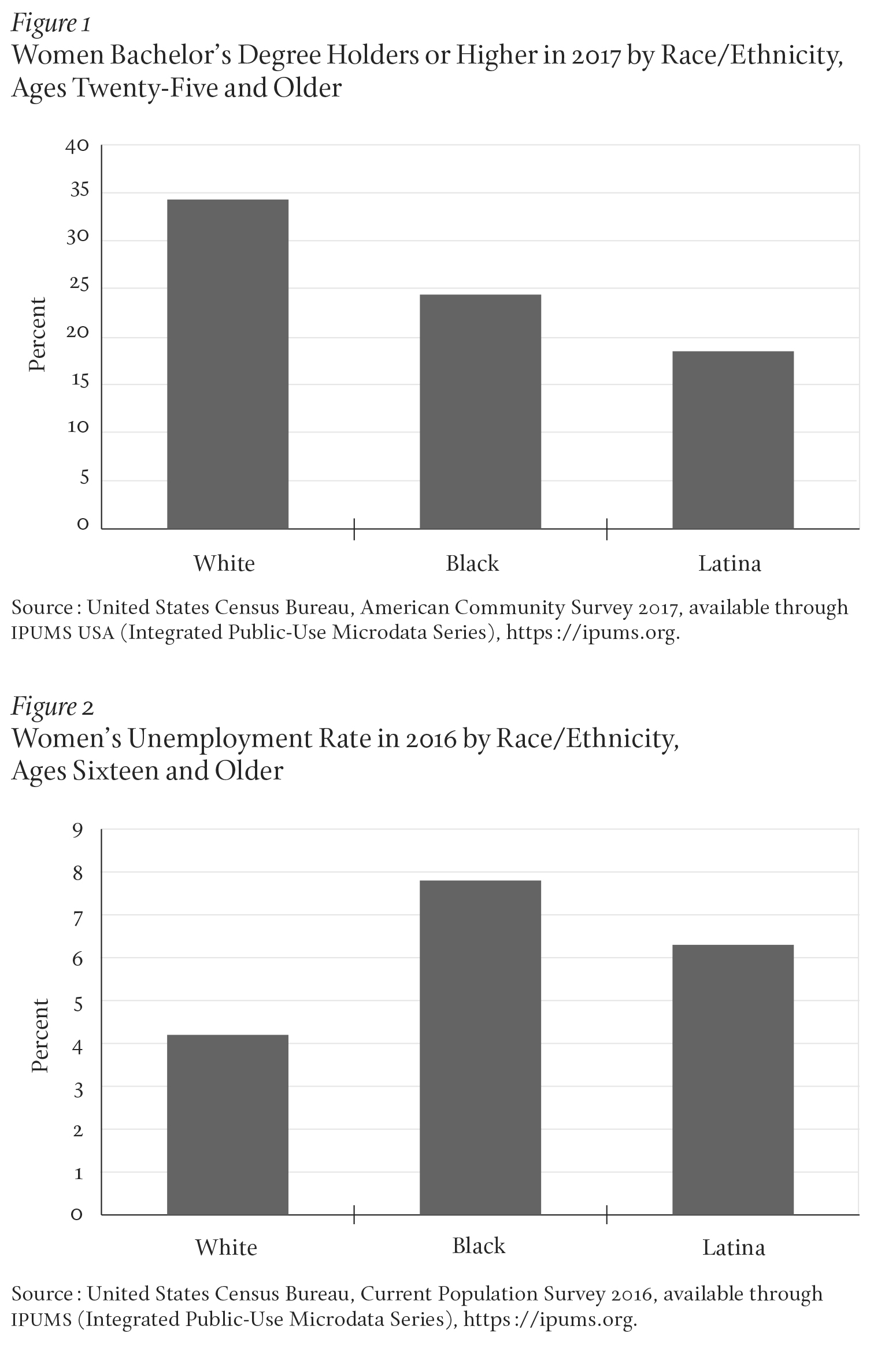
Turning to earnings, Figure 3 charts the wide disparity in median earnings between White, Black, and Latina women. In 2017, White women’s weekly earnings were $814 per week, compared with $673 for Black women and $618 for Latina women.
Finally, a look at poverty uncovers comparable patterns. Figure 4 highlights racial differences in poverty rates. In 2013, White women had the lowest poverty rate (11.7 percent), followed by Latina women (24 percent) and Black women (25.7 percent). It is quite striking that White women are less than half as likely as either Black women or Latina women to be living in poverty.
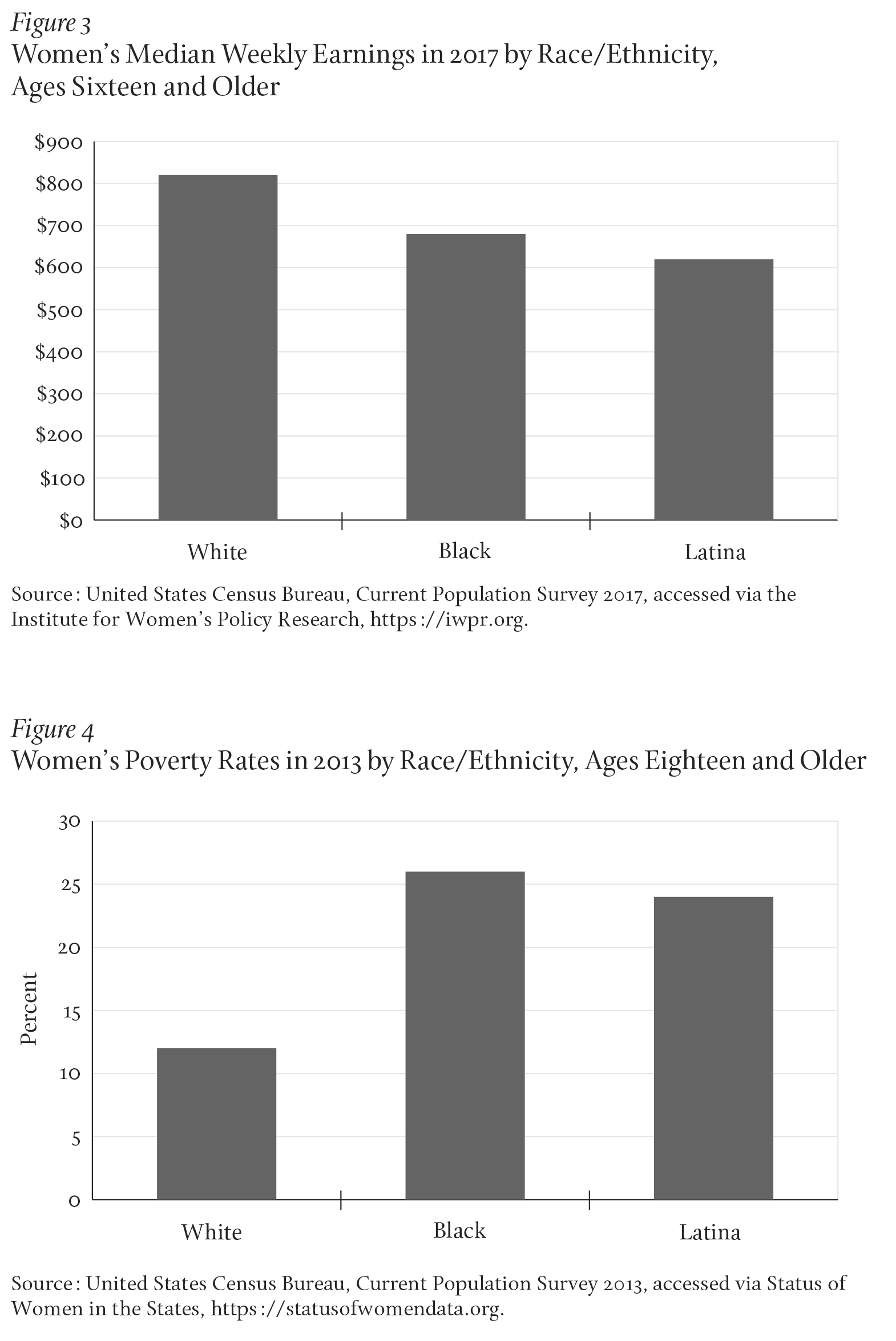
The patterns shown above are not surprising, but they are important. Disparities among groups of women are often muted or overlooked in favor of comparisons with men. White men generally outpace all women economically.31 Black men sometimes fare worse than Black women (especially with respect to educational outcomes).32 Comparisons to men across and within racial groups are often highlighted over and above differences between women. By focusing on comparisons among women, we show that across most metrics of economic well-being, Black and Latina women are considerably disadvantaged.
What role does public policy play in structuring this state of affairs? Making strong causal arguments is beyond the scope of this essay. It is difficult enough to make a convincing case that a single policy intervention has affected a single economic outcome for a single racial group. We cannot offer causal evidence that a set of economic and social policies caused aggregate changes in multiple patterns of inequality across numerous groups of women. Instead, we offer correlational analyses to make a prima facie case that state-level social and economic policies have varied implications across groups of women. We argue that this highlights the need for careful thinking about the heterogeneity of policy effects. We cannot fully explain why the specific patterns we find exist. Instead, we use these analyses as a springboard for encouraging further exploration of the policy dimensions of racial differences in economic outcomes.
Our immediate empirical objective is to gauge whether state-level social policies have varying associations with women’s economic status across racial groups. Our emphasis is on the racially heterogeneous individual-level upshots of state-level policy. This means that we are not primarily concerned with whether receiving a particular policy benefit at the individual level is associated with improved individual-level economic positioning. Rather, we highlight whether the type or generosity of benefits at the state level correlates with individual-level economic status. Put most straightforward, we consider the consequences of state-policy choices for individual-level outcomes.
Empirically identifying the relationship between economic status and public policy is difficult for numerous reasons.33 In particular, economic status is correlated with both access to and experiences with public policy, especially at the individual level. Using state-level policies as our main independent variables helps to mitigate this. More substantively, taking this approach allows us to consider the consequences of state-level policy regimes for women across racial groups. This is in line with our larger emphasis: not on the discrete “effects” of any single policy for an individual person who receives that policy benefit, but on the overarching role of social and economic policy in structuring outcomes for women.
We also recognize that one’s economic position is complex and not dependent on one factor, such as wages or poverty. Thus, we make the choice to include an index variable that accounts for this complexity. We conceptualize economic status as an (additive) function of three factors that each (dichotomously) reflect an important aspect of respondents’ position in the economy: 1) whether a respondent had any education beyond high school; 2) whether a respondent is below or above the official poverty line; and 3) whether a respondent earns a wage above the median of sampled respondents. We chose to include dichotomous measures of these outcomes because these markers (such as having college experience or being below or above the poverty line) are often associated with substantial differences in economic trajectory.34 The index we created gauges respondents’ combined positioning in each of these domains. Increasing scores indicate more “positive” economic status (the highest-scoring respondents have an education beyond high school, wages above the median, and are not living in poverty).
To construct this economic status index, we used 2009 individual-level micro-data from the Annual Social and Economic Supplement of the Current Population Survey (CPS) available through the Integrated Public Use Microdata Series (IPUMS).35 The CPS contains responses from over seventy-five thousand Black, White (non-Hispanic), and Hispanic/Latina women across the United States.36 We selected 2009 as the year for our analysis both for ease and for its theoretical value. Our honesty about presenting correlations (as opposed to causal estimates) follows from this choice. Coming at the tail end of the most recent recession (2007–2009), 2009 was one of the most difficult years in recent economic memory, and the supportive and stabilizing effects of public policy were acutely important during this time. We thus underscore a time that is especially significant vis-à-vis how policy operates when women are most vulnerable in the larger economy.
Our key independent variables gauge social and economic policy at the state level. These variables come from multiple sources, but each is housed in the Correlates of State Policy database.37 Our social policy variables include measures of states’ provision of food assistance (levels of SNAP and WIC participation), cash (TANF benefit levels), and health care (proportion of population with any public health insurance). Our economic policy variables include measures of the state EITC rate; the availability of state disability insurance; an indicator of whether the state minimum wage is above the federal minimum; an indicator of whether a state has prevailing wage laws; and a measure of states’ average amount for unemployment compensation. Finally, we incorporate a basic set of controls at the individual level (from the CPS), including age, marital status, number of children, citizenship status, disability status; and at the state level (from the Correlates of State Policy data set), including state poverty rate and state general expenditures.38
To examine the correlations between economic status and state policy, we employ multilevel regression.39 Following the theoretical expectations described earlier, we model economic status separately for each racial/ethnic subgroup as well as for women who are employed and unemployed.
Recall that the goal of these models is to assess the heterogeneity of correlations between women’s economic status and state-level public policy across racial groups. Tables 1 and 2 along with Figure 5 illustrate significant heterogeneity.40 We can neither explain nor account for each of the correlations. Instead, we describe some notable patterns. State TANF policy has few significant correlations with women’s economic status, with one exception: a marginally significant economic boost for unemployed Latina women.41 Higher levels of state SNAP benefits are moderately (positively) correlated with economic positioning for employed White women. More expansive WIC policy appears to correlate significantly (and positively) to economic status for unemployed Black and White women. State provisions of public health insurance are associated with more positive economic status for unemployed Latina women. A higher state EITC rate stands out as having positive associations with improved economic status for employed Black and White women, and even for unemployed Black women. However, the EITC is not correlated with Latina women’s economic positioning. State minimum wage laws that are above the federal minimum wage are associated with economic improvements for both employed and unemployed White women, while prevailing wage laws are (marginally) negatively correlated with economic positioning for employed White women. State unemployment compensation is (marginally) negatively correlated with unemployed Latina women’s economic status.
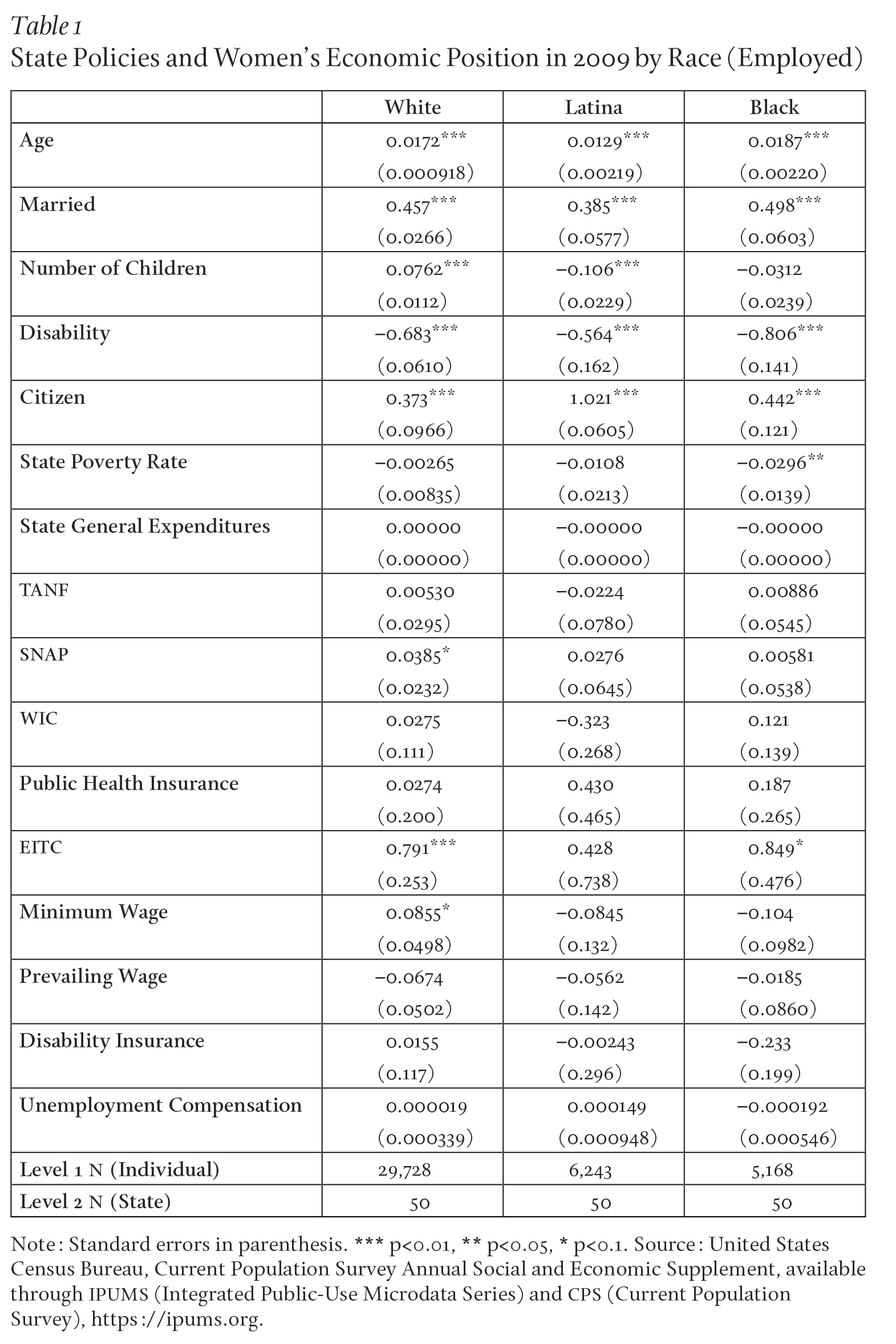
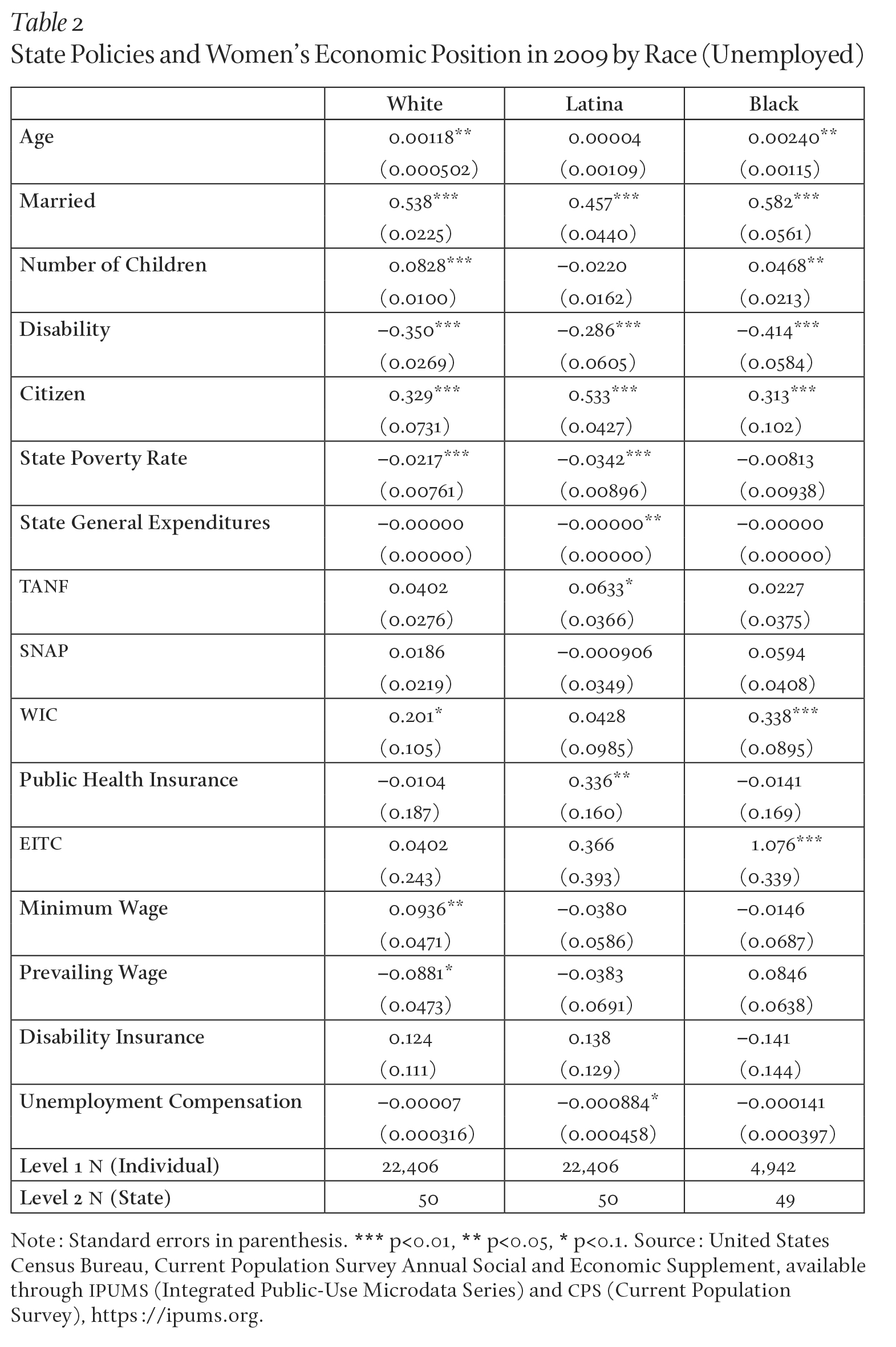
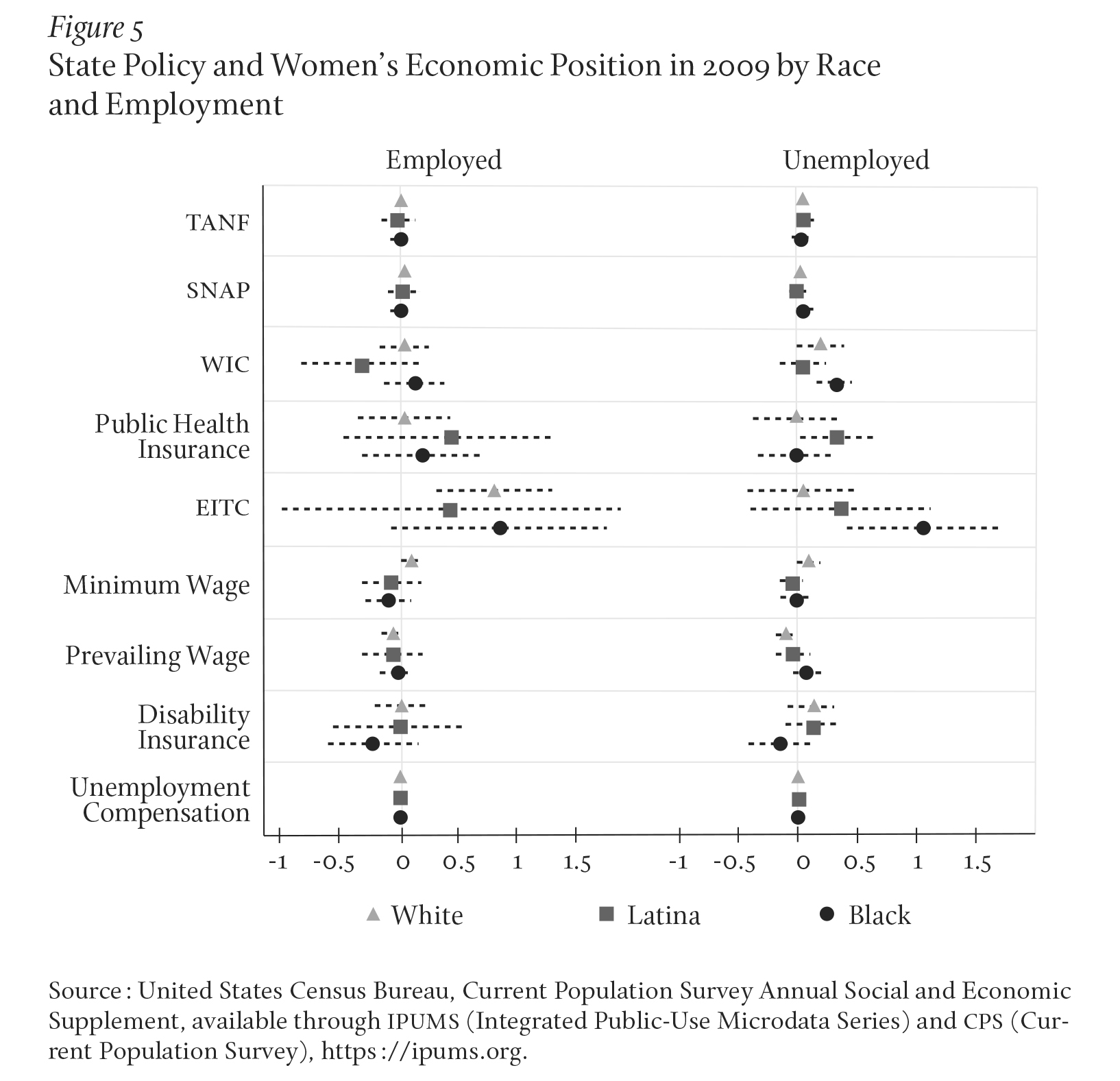
While we offer no easy takeaways, our central argument is that women’s economic positioning and the policies that shape it are heterogenous across racial and ethnic groups. We offer an index variable as a way of measuring the complex positionality of women in the economy. Our goal in doing so is not to determine a perfect measurement of economic standing, but to account for the multidimensionality of women’s economic positionality in the United States. When we study the relationship between this positionality and public policies, we find considerable differences among women.
Indeed, we find that public policies have significant (positive and negative) relationships with women’s economic position that differ by race and ethnicity. Although Latina and Black women share many similarities in terms of how they are disadvantaged by the labor market, their economic positions have very different relationships with social and economic policies. For Latina women, TANF and public health insurance are positively correlated with their economic position while for Black women, WIC and EITC are positively correlated. Meanwhile, though both White and Black unemployed women’s economic positions are positively correlated with state WIC policy, no such correlation exists for Latina women. These outcomes are important because they illustrate that differences among women–their employment status, race, ethnicity–underlie variation in the relationships between their economic standing and policies that are facially neutral.
We do not attempt to determine the causal mechanisms driving these differences among women. Instead, we point to well-established mechanisms from previous literature to make sense of the observed inequities. Political institutions like federalism and partisanship both structure and incentivize unequal policy benefits, divergent policy experiences, and inequitable policy outcomes for people across states, localities, and demographic categories. These institutional parameters map onto state racial and ethnic composition. In this way, institutions and the forms of policy design and implementation that they enable shape the extent to which policy is either a buffer against inequality or a channel through which it operates. We provide state-level policy analyses to highlight some of these processes, not to determine the specific mechanisms driving inequality among women, but to illustrate that state policy regimes have racialized consequences for women’s economic standing.
One of our key contributions here is to underscore the policy implications of an intersectional approach to economic inequality. Women of Color are in a uniquely precarious economic position in the United States. Making significant progress with regard to poverty reduction and economic mobility hinges in significant part on their economic status and trajectory. More fully understanding that trajectory –and the policy avenues for altering it–requires attentiveness to how policy operates across racial groups. Moreover, the dual policy dimensions we concentrate on here (social policies and economic policies) are often considered separately, either with respect to individual policies or with respect to only one policy dimension. Though the correlations we highlight should not be taken at face value, they do provide prima facie evidence that in the realms of both social policy and economic policy, the choices that we make about how and where to invest have differential consequences for racial disparities among women. We hope to encourage scholars to ask why, to delve more deeply into specific mechanisms, and to more thoroughly identify the processes that account for heterogeneous policy effects across racial groups. Racial equitability is one important metric by which we can prioritize and assess policy. First, however, we must ask and answer many more questions about the contours of racially heterogeneous policy effects.
